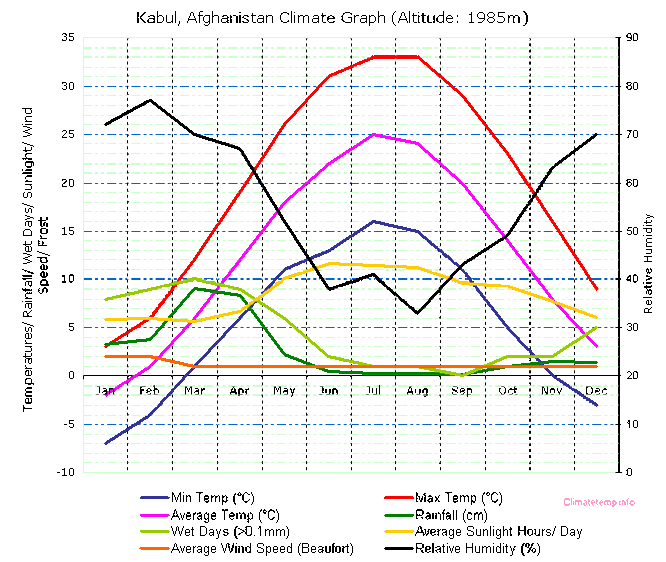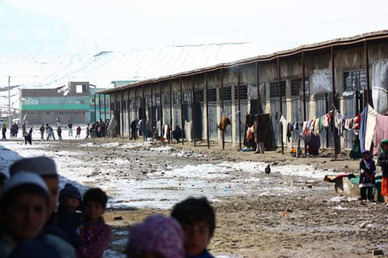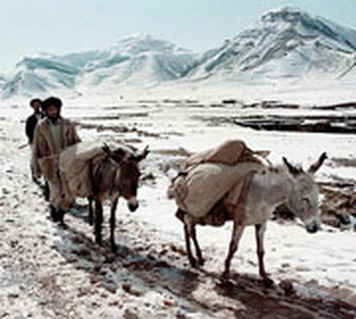Weather of afghanistan
By: Austin Volking
Afghanistan's weather is a big part of its country as a whole from living, and lifestyles. It also plays a big part in combat situations.
Click here to edit
Average Temp, percipitation, and Wind Speed of
Afghanistan

As you can see by the graph to the left, the hottest time of the year is in fact June through July which is normal for most climates. Though rainfall is at an
extreme low during these months giving Afghanistan the sand, dust, and heat
waves the country is known for. Also being so hot, and without rain in the summer months humidity goes way down. It just makes it very dry; almost to the
point if you’re caught outside without being covered you will suffer.
("Afghanistan climate guide," 2011)
extreme low during these months giving Afghanistan the sand, dust, and heat
waves the country is known for. Also being so hot, and without rain in the summer months humidity goes way down. It just makes it very dry; almost to the
point if you’re caught outside without being covered you will suffer.
("Afghanistan climate guide," 2011)
("Afghanistan climate guide," 2011) (used for graph above)
Weather affecting combat situations.
In the world of modern combat weather is starting to play more, and more of a role. You
cannot do certain operations when you are battling dust storms, and all sorts of
other natural assurances. Also ground forces can't operate well during the
hottest parts of the day especially if they have not been hydrating like they
are instructed to. We are also seeing more and more helicopters being dropped
out of the sky from poor visuals on ground forces.
(Cogan, 2008)
cannot do certain operations when you are battling dust storms, and all sorts of
other natural assurances. Also ground forces can't operate well during the
hottest parts of the day especially if they have not been hydrating like they
are instructed to. We are also seeing more and more helicopters being dropped
out of the sky from poor visuals on ground forces.
(Cogan, 2008)
Weather affecting living conditions

As you can see on the picture to the left, living conditions are
not the best in some parts of Afghanistan. People are being driven into these
shacks, and they don't have the luxury of air conditioning. It can average to 90
degrees easily in the summer. Though the cement walls are a good cover from
wind, and rain it can be very inconvenient for anyone living inside. They lack
the support of closed windows for when the dust starts to get kicked up by the
wind. Drought is also a common thing in these types of dry countries. People
have to go to a centralized water source where they can find water easily, but
they do have to carry it back to where ever they live which could be 1,2, maybe
even 5 miles. One of the biggest issues is finding clean water to drink, and so
it is very important to find ways to get the basic necessities, or anything
close.
("Afghanistan: bleak living," 2010)
("Afghanistan:bleak living," 2010) (picture above
not the best in some parts of Afghanistan. People are being driven into these
shacks, and they don't have the luxury of air conditioning. It can average to 90
degrees easily in the summer. Though the cement walls are a good cover from
wind, and rain it can be very inconvenient for anyone living inside. They lack
the support of closed windows for when the dust starts to get kicked up by the
wind. Drought is also a common thing in these types of dry countries. People
have to go to a centralized water source where they can find water easily, but
they do have to carry it back to where ever they live which could be 1,2, maybe
even 5 miles. One of the biggest issues is finding clean water to drink, and so
it is very important to find ways to get the basic necessities, or anything
close.
("Afghanistan: bleak living," 2010)
("Afghanistan:bleak living," 2010) (picture above
Winters in Afghanistan.

Afghanistan might be in the Middle East, but it still suffers brutally cold winters due to the mountains, and neighboring countries such as Russia. Though you only really she these brutally cold temperatures in higher elevations it is still chilly, and brutal winds that swoop down into lower parts of the country. The country definitely suffers from its ups, and downs in weather.
(Vaccarro, 2001)
(Vaccarro, 2001)
Works cited
Afghanistan climate guide to the average weather & temperatures with
graphs elucidating sunshine and rainfall data & information about wind
speeds & humidity: . (2011, july 8). Retrieved from http://www.afghanistan.climatetemp.info/
The world factbook. (2011, August 23). Retrieved from
https://www.cia.gov/library/publications/the-world-factbook/geos/af.html (used for flag, and picture on top of page)
Cogan, J. (2008, May 07). Fighting intensifies across afghanistan.
Retrieved from http://www.wsws.org/articles/2008/may2008/afgh-m07.shtml
Afghanistan: bleak living conditions for idps in kabul. (2010, February 16). Retrieved from
http://www.doctorswithoutborders.org/news/article.cfm?id=4267&cat=field-news
Vaccaro, C. (2001, April 10). Rugged landscape creates extreme afghan
weather. Retrieved from http://www.usatoday.com/weather/world/2001/afghanistan-climate.htm
graphs elucidating sunshine and rainfall data & information about wind
speeds & humidity: . (2011, july 8). Retrieved from http://www.afghanistan.climatetemp.info/
The world factbook. (2011, August 23). Retrieved from
https://www.cia.gov/library/publications/the-world-factbook/geos/af.html (used for flag, and picture on top of page)
Cogan, J. (2008, May 07). Fighting intensifies across afghanistan.
Retrieved from http://www.wsws.org/articles/2008/may2008/afgh-m07.shtml
Afghanistan: bleak living conditions for idps in kabul. (2010, February 16). Retrieved from
http://www.doctorswithoutborders.org/news/article.cfm?id=4267&cat=field-news
Vaccaro, C. (2001, April 10). Rugged landscape creates extreme afghan
weather. Retrieved from http://www.usatoday.com/weather/world/2001/afghanistan-climate.htm
